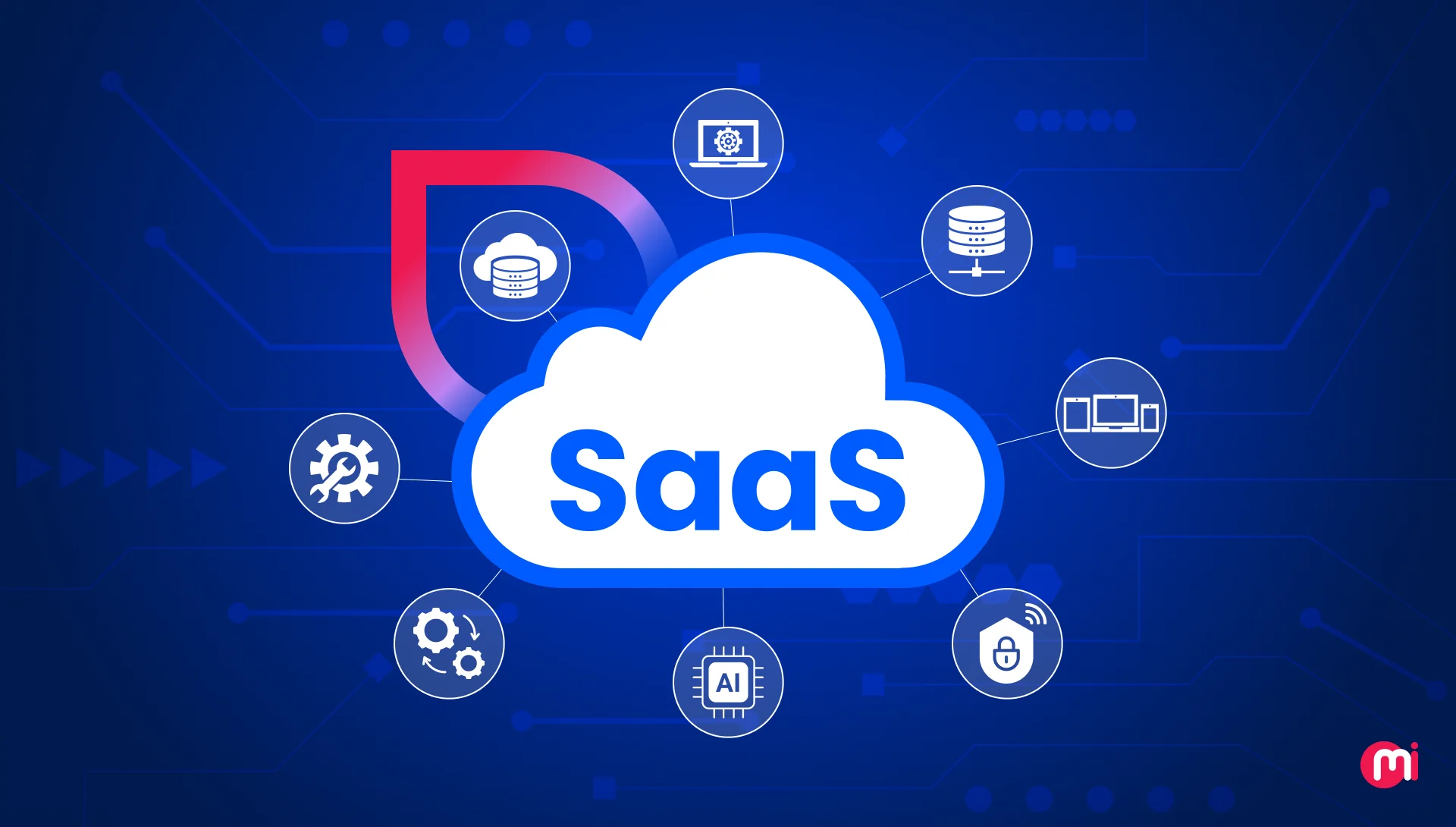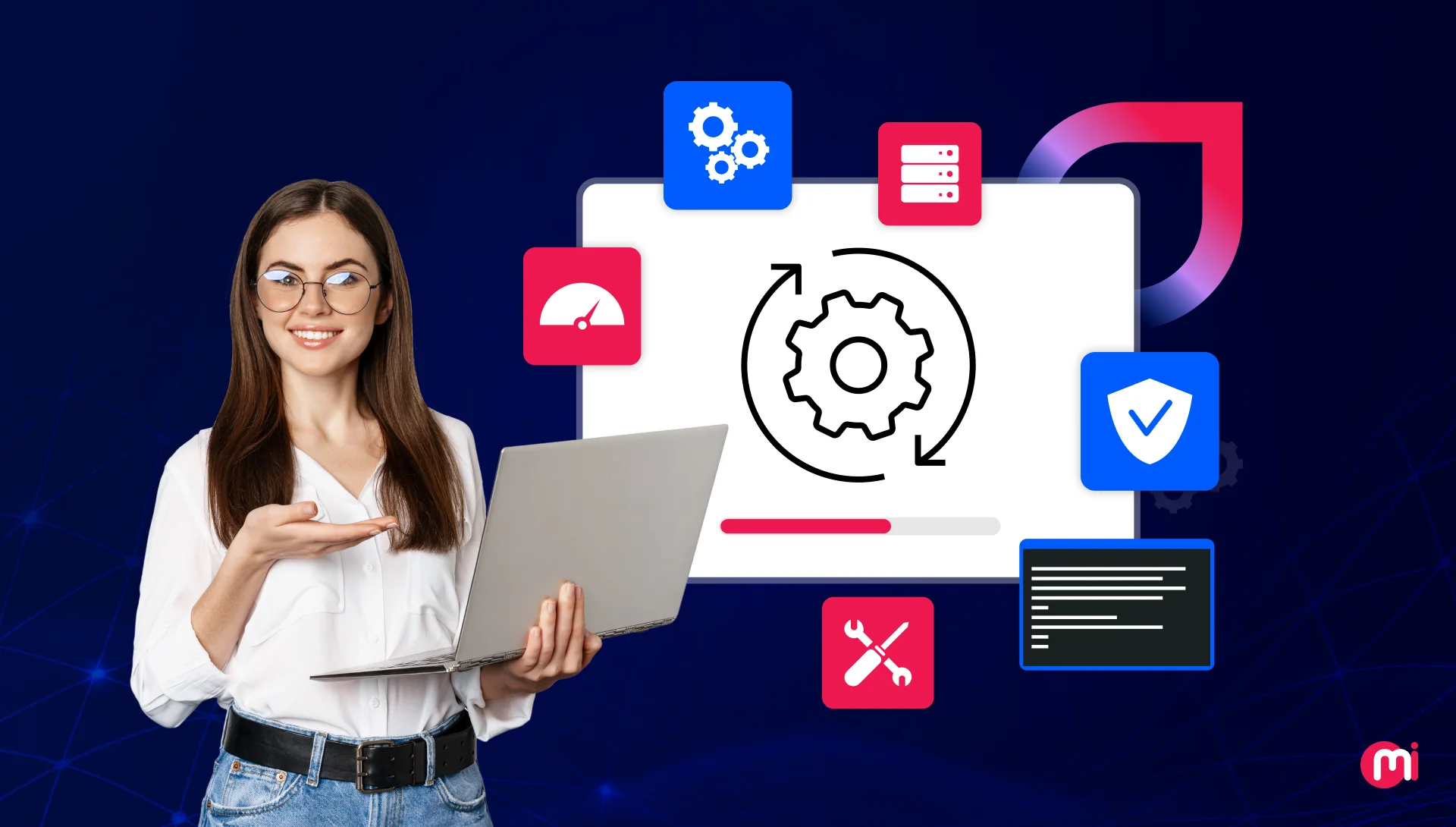Top 10 SaaS Trends in 2025
- Software
- November 10, 2025
SaaS trends, similar to other industries, tend to change. In 2025, the top SaaS trends include AI-driven automation, vertical SaaS & micro SaaS for industry specialization, flexible & use-based pricing, AIaaS, data privacy & trust, API-first & composable ecosystem, and many more. Businesses willing to thrive in this competitive SaaS landscape must adapt to these trends.
Leading SaaS brands such as HubSpot, Canva, CollabCRM, Salesforce, Receipt AI, Shopify, and Stripe leverage these trends to differentiate their products and stand out in the SaaS marketplace. Adapting to evolving SaaS trends helps them keep up with end-users’ requirements and remain relevant & time-tested.
This blog explores the top 10 SaaS trends in 2025 that are redefining how businesses build and scale software as a service solutions. Whether you’re a founder, product strategist, or CXO, these trends will help you future-proof your SaaS business and stay ahead in this fast-moving market.

Key Takeaways:
- AI and automation are redefining SaaS value creation, enabling smarter workflows, predictive insights, and hyper-personalized user experiences.
- Vertical and Micro-SaaS models are driving deeper specialization, helping companies serve niche markets with precision and scalability.
- Flexible, usage-based pricing and composable architectures are empowering customers with more control, transparency, and adaptability.
- Data privacy, embedded cybersecurity, and ethical practices are becoming key differentiators for customer trust and long-term growth.
- Global expansion and sustainability-focused innovation mark the next phase of SaaS evolution, where intelligent design meets responsible scale.
What are the Top 10 SaaS Trends in 2025?
The top SaaS trends for 2025 include the widespread integration of AI & machine learning, the growth of specialized vertical SaaS & smaller micro-SaaS solutions, and the expansion of low-code/no-code platforms, and many more. Additional key SaaS trends are enhanced cybersecurity, the adoption of usage-based pricing, the increasing importance of API integration to the architectures & system integration, and many more.
Here are the top 10 SaaS trends you should explore to know the future of SaaS to make the most out of your SaaS development initiative:
1. AI-Driven Automation Becomes the Core of SaaS Value
AI and machine learning (ML) in SaaS (Software as a Service) integrate intelligent capabilities like automation, personalized recommendations, and predictive analytics to make it smarter, more efficient, and user-friendly. This fusion fosters enhanced user experience, improves operational efficiency, strengthens security, and provides deeper data-driven insights.
Integrating AI/ML is one of the SaaS trends in 2025 that significantly changes how businesses use and develop SaaS solutions.
Benefits:
- AI automates repetitive processes, allowing teams to focus on higher-value strategic work that results in enhanced productivity.
- From predictive analytics to personalized dashboards and chatbots, AI helps SaaS companies deliver hyper-relevant user experiences.
- AI ensures smarter, data-driven decision-making and scalable automation with minimal manual input.
Example: HubSpot’s AI-based workflow automations and Canva’s AI design suggestions demonstrate how AI boosts productivity.
Businesses can’t afford to react to what their customers want; they need to anticipate their needs.
~ Parker Harris, co-founder – Salesforce.
2. Vertical SaaS and Industry Specialization Accelerate Growth
Vertical SaaS is cloud-based software specifically designed for the unique needs of a particular industry, such as healthcare, real estate, construction, and finance. In 2025, this specialization is driving massive adoption, as companies demand tools that align closely with their workflows, compliance needs, and customer expectations.
This shift allows SaaS providers to offer tailored functionalities and deep integrations. It enables them to deliver higher value by solving deep, domain-specific challenges instead of providing broad, one-size-fits-all functionality.
Benefits:
- Offers tailored solutions that align perfectly with industry requirements
- Reduces implementation time through pre-configured workflows
- Builds stronger customer loyalty through niche expertise
- Enhances scalability within vertical ecosystems
Example: CollabCRM is a complete business management solution for IT companies, catering to their comprehensive needs. From people to project management, invoice management, and more, this SaaS solution ensures complete project management through industry-focused features.
Also Read: Cloud Vs SaaS.
3. Rise of Micro-SaaS and Product-Led Growth Models
Micro-SaaS is one of the SaaS trends in 2025, because they are lightweight, highly focused tools that solve one problem exceptionally well. Combined with a Product-Led Growth (PLG) approach where the product drives acquisition, retention, and expansion, this model is redefining how SaaS startups scale in 2025.
Micro-SaaS businesses thrive because they allow for smaller, more agile companies. They solve specific problems for a niche audience, leading to higher revenue growth and user adoption compared to traditional SaaS.
Benefits:
- Faster go-to-market cycles and reduced development costs
- Clear product-market fit attributed to the niche targeting
- Organic growth through self-serve onboarding and referrals
- Scalable revenue with minimal marketing spend
Example: Receipt AI is an excellent example of a micro SaaS solution that uses a phone’s camera to capture receipts and converts the information into a format that can be used by accounting software like Xero or QuickBooks. It saves 97% of users’ time by uploading receipts to Xero or QuickBooks from their phones.
4. Flexible and Usage-Based Pricing Takes Center Stage
Traditional subscription models are evolving to include usage-based pricing, allowing users to pay for what they use, aligning costs with value. Customers increasingly prefer paying for what they use rather than flat-rate subscriptions. In 2025, usage-based pricing enables SaaS providers to align cost with customer value, improving satisfaction and creating predictable, scalable revenue models.
Usage-based pricing models for SaaS allow customers to pay for the software based on their actual use, such as per API call, data storage, or transactions. For founders, it transforms pricing from a static structure into a growth lever and fosters long-term loyalty and increases retention.
Benefits:
- Lowers entry barriers for new customers
- Encourages efficient usage and fair billing
- Scales revenue in line with customer success
- Builds transparency and trust in pricing
Example: Twilio and AWS pioneered usage-based models, letting customers pay only for used services, making them more attractive, useful, and accessible to startups and enterprises alike.
Also Read: How to Bootstrap a SaaS Start Up?
5. AI-as-a-Service Becomes the Foundation for Innovation
AI-as-a-Service (AIaaS) enables SaaS businesses to integrate ready-to-use AI tools and APIs without developing their own machine learning infrastructure. This democratizes innovation, allowing even small teams to embed AI intelligence into their products at minimal cost.
In 2025, AIaaS is one of the SaaS trends that helps business leaders accelerate development, experiment with advanced features, and stay competitive without deep AI expertise.
Benefits:
- Reduces R&D and infrastructure costs
- Speeds up product innovation and experimentation
- Enhances user experiences through intelligent automation
- Levels the field for startups competing with enterprise giants
Example: One of the AIaaS examples is Grammarly, which leverages AIaaS for natural language processing. Canva also integrates AI APIs to enable design automation and content generation.
Also Read: What is AIaaS?
6. Data Privacy, Trust, and Compliance as Competitive Advantages
Data privacy is no longer just a compliance task; it’s a brand differentiator, and therefore, is one of the SaaS trends in 2025. SaaS companies that prioritize transparent data handling, regulatory readiness, and security earn stronger customer trust and enterprise adoption.
With stricter laws like GDPR and the EU AI Act, data governance now defines credibility and market access. It brings plenty of benefits to SaaS businesses.
Benefits:
- Builds long-term customer confidence
- Protects against costly compliance violations
- Strengthens enterprise appeal and global expansion readiness
- Improves transparency and ethical data use
Example: Salesforce and Atlassian highlight privacy and compliance in their messaging, making trust a key component of their value proposition.
7. API-First and Composable Ecosystems Drive Speed and Scale
SaaS solutions are increasingly built with an “API-first” approach, making it easier to connect and integrate with other software and services. An API-first and composable architecture approach allows SaaS products to remain flexible, modular, and easily integrated with other platforms. In 2025, businesses increasingly prefer ecosystems that can evolve quickly without disrupting core operations.
For SaaS strategists, it means faster innovation, reduced vendor lock-in, and better customer retention through adaptability.
Benefits:
- Enables faster integrations and product scalability
- Simplifies customization for different business needs
- Encourages partnerships through open ecosystems
- Reduces time-to-market for new features
Example: Shopify and Stripe leverage this SaaS trend, and their success lies in API-first design, which enables developers to build and extend functionality easily across global ecosystems.
8. Cybersecurity-Embedded SaaS Enhances Customer Retention
Cybersecurity is a SaaS trend in 2025. As threats evolve, embedding security at every layer from authentication to data storage is essential for trust and retention. It includes the adoption of Zero Trust Architecture, increased reliance on AI for threat detection, and a greater focus on securing APIs and third-party integrations.
Additionally, organizations are prioritizing enhanced data encryption, multi-factor authentication, and the use of security posture management (SPM) and cloud security posture management (CSPM) tools to address evolving threats like AI-powered attacks and supply chain vulnerabilities.
In 2025, customers prefer SaaS providers who demonstrate security leadership rather than mere compliance.
Benefits:
- Prevents breaches and data loss
- Increases customer confidence and retention
- Reduces downtime and reputational risk
- Simplifies enterprise procurement processes
Example: Zoom rebuilt its reputation by integrating end-to-end encryption and proactive privacy controls after early security challenges.
9. Global SaaS Expansion through Localization and Regulation Readiness
Globalization is driving SaaS growth, but success requires more than translation. Therefore, global SaaS expansion through localization is one of the SaaS trends in 2025. SaaS companies localize experiences from language and payment methods to regulatory compliance and cultural preferences.
This approach helps SaaS brands build trust, meet legal requirements, and connect authentically with regional audiences.
Benefits:
- Expands market reach across regions
- Improves adoption through native user experiences
- Strengthens compliance with local regulations
- Builds global brand credibility
Example: Freshworks and Zoho grew internationally by leveraging UI/UX design services and offering localized pricing, support, and multi-language options that resonate with diverse audiences.
10. The Shift Toward Sustainable and Ethical SaaS
Sustainability and ethical responsibility are defining factors for SaaS companies in 2025. Customers and investors expect transparency in environmental impact, data ethics, and governance practices. Adopting green infrastructure and responsible AI practices is now essential for brand reputation and long-term viability.
The key trends for sustainable SaaS include leveraging AI for ESG data, the rise of impact investing, new frameworks like the TNFD, and the development of ESG SaaS platforms to help companies manage energy and sustainability initiatives.
Benefits:
- Enhances brand image and investor confidence
- Meets ESG (Environmental, Social, Governance) criteria
- Reduces operational costs through efficient infrastructure
- Attracts socially conscious clients and employees
Example: Salesforce and Microsoft are leading sustainable SaaS by committing to renewable energy and carbon neutrality across their operations.

Wrapping Up!
The SaaS landscape of 2025 is fast, intelligent, flexible, and purpose-driven. Emerging SaaS trends like AI-driven automation, vertical SaaS, and usage-based pricing show how the industry is maturing, moving toward efficiency, specialization, and transparency. Founders and leaders who act early on these shifts will gain a decisive competitive advantage.
The key lies in balancing innovation with trust, embedding AI for smarter value, localizing for global reach, and operating with sustainability at the core. Ultimately, the SaaS companies that thrive in 2025 won’t just deliver software, they’ll deliver ecosystems of growth, intelligence, and integrity.
If you’re ready to evolve your SaaS product for the next generation of users, now is the time to act. MindInventory is a leading SaaS development company that embraces these SaaS trends and offers comprehensive SaaS development solutions to businesses of all sizes. If you need additional assistance, whether it’s SaaS consulting or complete SaaS development services, we’ll help you with a complete solution.
FAQs on SaaS Trends
Among many SaaS trends in 2025, AI-driven automation, as it impacts efficiency, customer experience, and product innovation across all SaaS categories, is the most important trend.
Small companies can leverage AI-as-a-service by integrating AI APIs into their product instead of building complex models from scratch, reducing costs and speeding up innovation.
Vertical SaaS is industry-specific SaaS that solves niche-specific problems, builds trust, and helps companies comply with sector regulations for improved efficiency.
The top examples of flexible SaaS pricing models include usage-based, pay-as-you-go, and tiered pricing based on feature access or consumption.
SaaS companies can grow globally by localizing content, supporting regional payment methods, complying with local regulations, and ensuring platform scalability.













